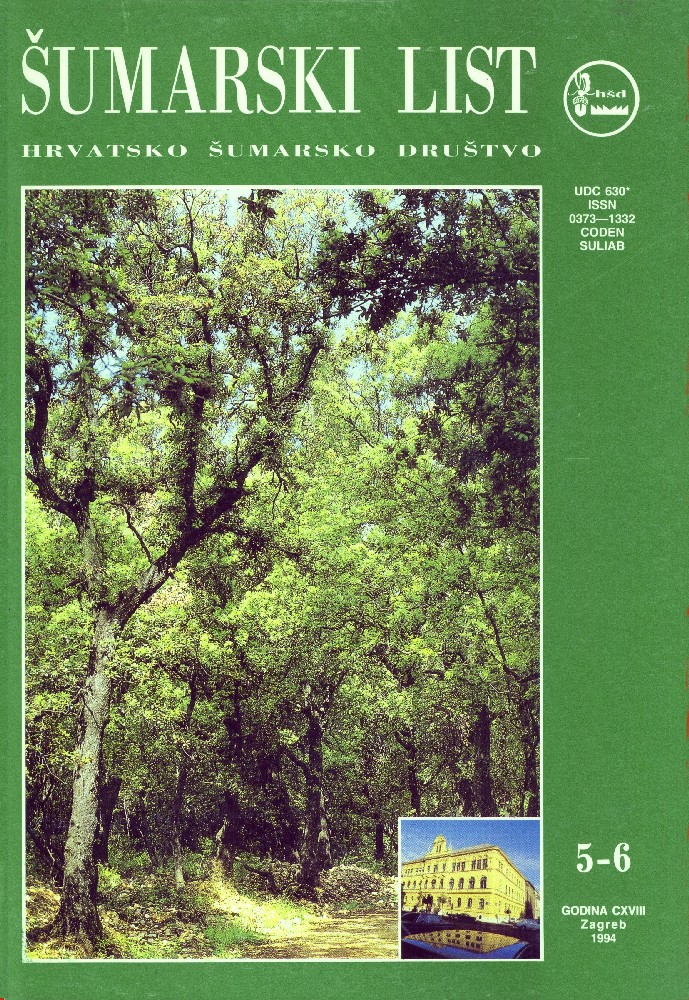
broj: 5-6/1994
pdf (13,3 MB) |
|
||||||||||||||
| IZVORNI ZNANSTVENI ČLANCI | ||
| Orlić, S., Ocvirek, M. | UDK 630* 232.001/2 (Pseudotsuga menziesii (Mirb.) Franco) | |
| Research in Provenanses of Douglas Fir (Pseudotsuga menziesii (Mirb.) Franco) in Croatia pdf HR EN | 139 | |
| Komlenović, N., Krstinić, A. | UDK 630* 161.6 (Populus sec. Aigeiros and Tacamahaca) | |
| Some physiological Characteristic of Croatia Polar Clons of Sections Aigeiros and Tacamahaca pdf HR EN | 147 | |
| SUMMARY .Genotype differences have been investigated in six poplar clones (Populus nigra, Populus x euroamericana 1-214, Populus deltoides 618, Populus deltoides 457, Populus balsamifera, and Populus deltoides ssp. angulata) in nursery conditions, as to the number and size of the stomata, and the concentration and accumulation of nutrients in the leaves. Analyses have been made for the following nutritious elements: N, P, K, Ca, Mg, S, Fe, Mn, and Zn. Among the mentioned clones, genotype differences have been established as to the number and size of the stomata, and the concentrations and accumulation of nutrients in the leaves. The clones of the Populus deltoides 618 and Populus deltoides 457 generally have very high concentrations of nutrients in their leaves, while, owing to particularly large leaves, Populus deltoides 618 gathers the greatest amounts of the already analyzed nurients in a certain number of leaves. Populus deltoides 456 is characterized by particularly high concentrations of sulphur in its leaves. The greatest number of the stomata, both on the face and back of the leaf, is found in the clone Populus deltoides ssp. angulata. We found also statistical differences in respect to size of the stomata on the face and leaf back. The greatest length of the stomata have 1-214 and P. balsamifera clones. The obtained results show that there are remarkable differences as to the physiological features among the clones which have been reproduced in Croatian nurseries and grown in forest cultures. It is of great importance for successful vegetative progeny production and raising of poplar cultures and plantations, that the poplar clones are chosen in accordance to the given habitat, respecting their physiological status. In the future it is neccessary to investigate also the nutrient content of total biomass in nursary condition. Nutrient accumulation in weed vegetation is also important because weed vegetacion is in competition to poplars in nursaries and plantations. Key words: Populus, sections Aigeiros and Tacamahaca, concentrations and contents of nutrients, number and size of stomata Key words: Populus; sections Aigeiros and Tacamahaca; concentrations and contents of nutrients; number and size of stomata | ||
| Španjol, Ž. i Wolf, S. | UDK 630* + 712 | |
| Biological-Environmental and Space Valorization Park-Forest »Komrčar« on the Island of Rab pdf HR EN | 153 | |
| Huber, D., Radišić, B., Novosel, D., Frković, A. | UDK 591.5 (497.13) (Canis lupus) | |
| Survey of Public Atitude Twords Wolves in Croatia pdf HR EN | 167 | |
| STRUČNI ČLANCI | ||
| Tomašević, A. | UDK 630* 232.216 | |
| Undermining as First Stage of Soil Preparation for Afforestation pdf HR EN | 173 | |


